Click for
Sports Roadster
Sports Roadster
Click for
Landau
Landau
Click for
Sports Roadster Demonstration
Sports Roadster Demonstration
In January 1961 Lido "Lee" Iacocca replaced Robert McNamara (June 9, 1916-July 6, 2009) as the General Manager of Ford Division. McNamara left Ford to serve as Secretary of Defense under the Kennedy Administration, and had approved the 1962 models during Spring 1960. To say that McNamara and Iacocca viewed cars differently would be an understatement. McNamara was very conservative, and was motivated by the dollar. Iacocca had to watch the pennies at Ford, but viewed cars as pure excitement, adrenaline. He liked flash and speed.
Lee Iacocca was not impressed with Ford's model lineup for 1962. They were warmed over repeats of 1961. Apparently the public agreed, because as sales figures for the 1961 Thunderbirds were beginning to be tallied, it was apparent they were not keeping up the pace set by their predecessors. Iacocca had no time to make any real changes to the 1962 models, but felt that the top of the line Thunderbird models needed something new to create interest and draw customers into the showrooms.
Iacocca believed that by broadening the number of models offered by Thunderbird, more customers would be attracted to the dealer showrooms, where the salesmen would have the opportunity to sell them a different model if necessary. Since he would have very little time or money to work with, Iacocca would be limited to mostly cosmetic changes.
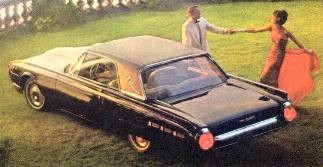 The Landau was the Thunderbird in evening dress. Basically a Hardtop with a Cobra-grain
vinyl roof covering glued to the roof. Offered in two color choices, black
or white, the vinyl had a long, deeply veined texture to it. This gave
it the appearance of leather. A felt pad was placed under the vinyl to
cushion, and classic simulated S-bars were designed to accentuate the roof
side panels. A 1958-1959 circa raised wing Thunderbird emblem, set against
either a black or white background (depending on the color of the vinyl
material) would be placed at the center of the chrome plated S-bars in
an enlarged circular area. The Landau contributed to higher sales figures
for 1962, and became the most popular Thunderbird model in 1966, a title
it would retain until the Landau was retired after the 1971 model year.
The Landau was the Thunderbird in evening dress. Basically a Hardtop with a Cobra-grain
vinyl roof covering glued to the roof. Offered in two color choices, black
or white, the vinyl had a long, deeply veined texture to it. This gave
it the appearance of leather. A felt pad was placed under the vinyl to
cushion, and classic simulated S-bars were designed to accentuate the roof
side panels. A 1958-1959 circa raised wing Thunderbird emblem, set against
either a black or white background (depending on the color of the vinyl
material) would be placed at the center of the chrome plated S-bars in
an enlarged circular area. The Landau contributed to higher sales figures
for 1962, and became the most popular Thunderbird model in 1966, a title
it would retain until the Landau was retired after the 1971 model year.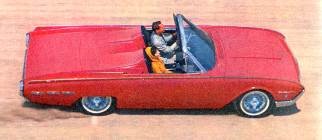 The Sports Roadster was a bit more challenging to design and build, but the idea was the same:
take a current body style, add additional cosmetic features to it to set
it apart, and give it a new name. This time, the Convertible would be the
model being modified, and the changes were spectacular. With this new model,
Iacocca was able to respond to dealers' complaints about the lack of a
two passenger model. When McNamara cancelled the original two passenger
Thunderbird in lieu of the four passenger version, many customers couldn't
believe it, and complained to their dealer. Four years later the complaints
were still coming in, so perhaps there was a small market segment for such
a car. The option of creating a car from scratch was not forthcoming, although
several prototypes would be considered but shelved due to cost, and lack
of a large enough customer base for a two passenger model.
The Sports Roadster was a bit more challenging to design and build, but the idea was the same:
take a current body style, add additional cosmetic features to it to set
it apart, and give it a new name. This time, the Convertible would be the
model being modified, and the changes were spectacular. With this new model,
Iacocca was able to respond to dealers' complaints about the lack of a
two passenger model. When McNamara cancelled the original two passenger
Thunderbird in lieu of the four passenger version, many customers couldn't
believe it, and complained to their dealer. Four years later the complaints
were still coming in, so perhaps there was a small market segment for such
a car. The option of creating a car from scratch was not forthcoming, although
several prototypes would be considered but shelved due to cost, and lack
of a large enough customer base for a two passenger model.Very quickly, a Tonneau Cover (or "coaming," as the designer's would refer to them) was proposed. Several questions would be raised about its use. For instance, 1) Could it be designed so that the top can be raised and lowered with it in place? 2) Is there a way to split it so that it can be stowed in the luggage compartment when not in use? 3) Will it interfere with front seat adjustment, especially the vertical control on the optional power seats? and 4) How will it be attached to the car without using visible fastening devices?
Some of the answers were simple, others were not. For instance, 1) Yes, the tonneau could remain in place during top operation without interference. 2) Due to space limitations in the luggage compartment, the tonneau would have to be stored elsewhere when not in place over the rear seat. 3) The headrest portion could be designed to allow for horizontal seat movement, but the vertical movement on the power seats would have to be disconnected. The final question seemed easy enough at first, 4) The rear edge of the tonneau can be fitted with metal tabs that will slide between the top of the rear seat back and the metal panel just behind the seat back. A concealed clamp would be installed between the front seats, behind the glove compartment, at the base of the cover to secure it in place. Shortly after introduction, Ford modified the Tonneau Cover by replacing the metal tabs at the rear edge with two chrome plated thumbscrews that screwed into threaded sockets in the panel behind the rear seat. This change was made to prevent lifting of the rear corners of the Tonneau Cover, and remained through the end of 1963 production.
Special attention was also given the area just behind the front seat backs, as a clean appearance was desired. It was decided that the tonneau would angle down below the beltline in this area, to accommodate front seat movement in the headrest area of the tonneau, as well as give the car a finished look with the door closed. This design would also allow placement of small articles on the rear seat, where they would be concealed from view with the cover in place.
In keeping with the sporty flair of this new model, chrome plated Kelsey-Hayes Wire Wheels were fitted to the car as standard equipment. These wheels would feature knock-off spinners, and would require special ventilated tires as well as inner tubes. Since the spinners would not clear the rear fender shields, the shields were not available as options on Sports Roadster models.
The stylists also created a special Thunderbird emblem to be affixed to the Sports Roadsters. This emblem would be placed on both front fenders, centered under the Thunderbird script. Another would be placed on the Tonneau Cover itself, between the front seat backs. As a final touch, a color-keyed padded vinyl passenger assist bar would be mounted on the instrument panel directly in front of the passenger.
Finally, a Thunderbird that could accommodate all customer requests: two passenger sportiness, four passenger convenience, fully automatic power top, and the ability to order factory air conditioning! It seemed like the perfect solution, but the Sports Roadster models received a chilly welcome from Ford's customers. What went wrong? Nobody knows for sure, but if you'll click the link in the previous sentence, we'll tell you what we think makes the most sense.
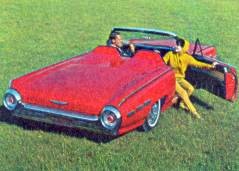
Photo #1
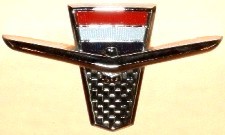
1962-1963 Thunderbird Sports Roadster Emblem
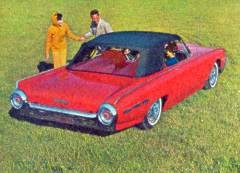
Photo #2
Photo #1, above, shows the Sports Roadster in its truest form; as sleek
as any sports car, yet with an arrogantly individual attitude. Touch Photo
#1 with your cursor, and you'll see that four deserving passengers may
travel when necessary by removing the cover.